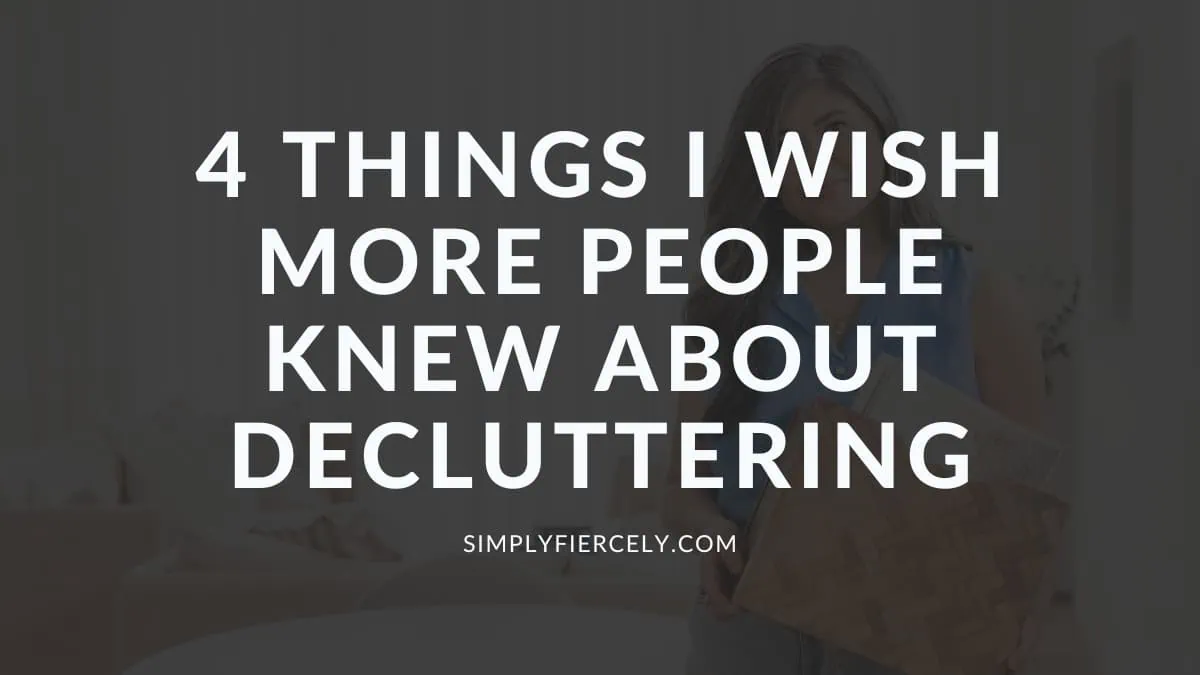Between this blog and client work, I’ve been helping people declutter since 2015. During that time, I’ve noticed patterns—thoughts and perspectives that keep people stuck—so today, I’m pulling back the curtain. As a former shopaholic turned full-time decluttering coach, here’s what I wish more people knew about breaking the clutter cycle.
There are two main types of clutter, and you have to tackle them differently.
Broadly speaking, there are two types of clutter.
The first is “junk”, like expired cosmetics, old magazines, and faded receipts. With these items, it’s more about cleaning than decluttering. There’s little emotional attachment and few hard decisions about what to keep.
Instead, you roll up your sleeves, put on a good playlist, and get to work—and with a bit of time and energy, you make progress …
Until suddenly, you’re stuck.
What used to work doesn’t work anymore, and this is because you’ve hit the wall with emotional clutter. (With the acknowledgement that someone’s “junk” might be emotional for someone else.)
It’s at this stage a lot of people find me, and they’re frustrated because the “elbow grease” strategy is no longer working. They’re not making progress and tend to beat themselves up, so sure that the solution is more effort and self-discipline—where in reality, emotional clutter requires a different approach.
Decluttering is no longer the same as cleaning. Working harder won’t get you unstuck, but compassion and curiosity about your relationship with clutter will change everything.
Clutter is a symptom, not a problem.
I know that owning too much stuff can be stressful, and no one wants to live in a cluttered home. But clutter in and of itself is rarely the problem.
Instead, it’s a symptom.
- Maybe you’re going through a hard time without a support network, so you use shopping to stay sane (I’ve been there!).
- Or perhaps you keep stuff because you didn’t own much growing up, and physical possessions bring a sense of security.
- Sometimes, it’s about confusion—you don’t know your personal style, so you buy everything (and wear nothing!).
The possibilities are endless, but getting to the roots of your clutter is the key to breaking the cycle. If you don’t, it’s like the decluttering equivalent of binge dieting—you might make short-term progress, but new stuff will catch up to you sooner or later.
Self-compassion is your secret weapon.
When I first started decluttering, I spent a lot of time beating myself up. Thoughts like “How did I let it get this bad?” and “Why is this so hard for me?” played on repeat, and every decluttering session felt like a painful walk down memory lane. It was hard to begin, hard to keep going, and even harder to make progress.
Once, I chalked my struggles up to a lack of self-discipline, but now I know better.
The real challenge most people face while decluttering is shame, and the horrible thoughts we have about ourselves make it so difficult to let go.
Put it this way—if you think you’re a terrible person for spending $200 on a dress you never wear, you’ll avoid decluttering at all costs. After all, who wants to see proof of their bad decisions? Instead, it’s more comfortable to tell yourself, “I’ll wear it one day,” … but one day never comes, and you’re left with an overflowing closet.
Until you break out my secret weapon:
Self-compassion.
When you forgive yourself for mistakes, you stop judging and start learning—which brings me to my next point …
If you don’t learn from your clutter, you’ll never break the cycle.
The best way to avoid clutter is to own less in the first place, which is why learning from your clutter is essential.
For every item you declutter, ask yourself questions such as:
Why don’t I wear/use this item? This tells you what you should avoid buying in the future. It can also help you identify similar items to declutter, thus reducing decision fatigue.
For example, I love the look of long dresses but seldom reach for them. Once I had this “ah-ha” moment, I was able to declutter multiple items in one swoop, and I stopped buying them in the first place.
How did this item end up in my home? Can you create a new boundary to avoid similar clutter in the future?
Your answer might hint at an area in your life where you need more support or care. For example, suppose you bought your item during a “retail therapy” shopping spree. In that case, investigating alternative forms of self-care might actually be the key to owning less!
Ultimately, clutter is complicated, and solutions are not one-size-fits-all. But taking a more holistic approach, where you investigate thoughts, beliefs, and habits, will almost always lead to more sustainable results. Plus, it feels better, and that’s a win-win in my book.
More Decluttering Tips and Advice
I wrote this post because experience has taught me perspective is everything.
Yes—tips, hacks and strategies help—but understanding your relationship with clutter is an essential first step. Shifting away from blame and towards a more compassionate curiosity has been vital for hundreds of clients and myself.
Then, you can start to apply tips and techniques such as these:
How to Declutter When You Want to Keep Everything – This is the exact advice I give clients who know their clutter is out of control but struggle because they want to keep everything.
5 Decluttering Methods You Haven’t Tried (That Really Work!) – These tried and tested methods will help you clear more clutter in less time.
How to Let Go of Sentimental Items While Decluttering – As a highly sensitive person, I know how hard it can be to declutter sentimental items—hard but not impossible. Here are some tips that have helped me and many clients as well.
10 Ways to Get Rid of Clutter Quickly + Easily – Some of my favourite decluttering tips!
